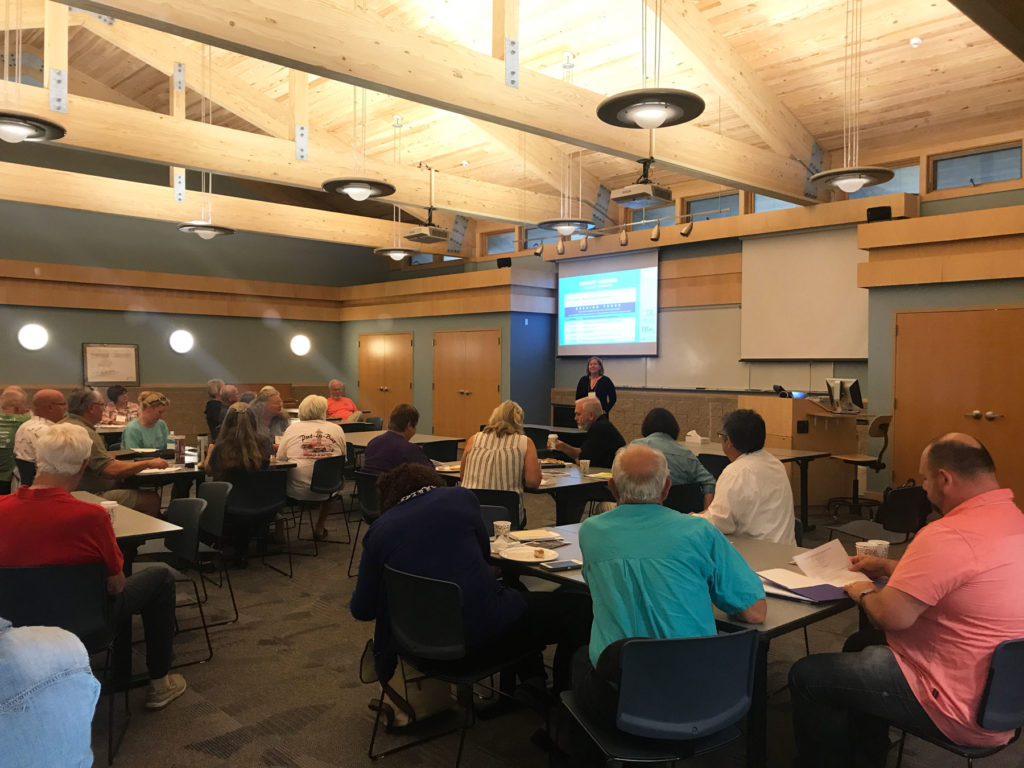Islanders from Michigan, Ohio, Wisconsin, and Canada stood at the bow of the Emerald Isle Ferry as it made the two hour crossing from Charlevoix to Beaver Island. The islanders, participants in the first Great Lakes Islands Summit held at the Central Michigan University Biological Station September 20-22, were naturally curious about other island communities.
How does your island run their ferry service? What does your school do for sports? How many people live in the community in the middle of January? How do you attract a qualified workforce? How do you get them to stay?
As my co-worker Karen and I stood at the rail watching Beaver Island grow from a blue smudge on the horizon into a sandy shoreline and scanning Lake Michigan for harbor porpoise and seals out of habit, we listened to the very same questions we hear grappled with in Maine.

The Beaver Island ferry landing
How do you keep energy affordable? How do you get services to the island? How do you encourage a diverse and thriving economy?
We were there, along with 70 other people from 12 Great Lakes island communities, Northland College, and the Michigan Office of the Great Lakes, to learn about what makes island communities thrive.
Some interesting facts we learned about the Great Lakes island communities:
- Beaver Island has developed a shoulder season economy, because their unique position in Lake Michigan attracts so many migrating bird species? They also have their own locally produced radio station.
- Drummond Island has 170 miles of closed loop trails open to all terrain vehicles. The state forest management plan works in complement to the tourist-based economies to allow so many motorized vehicle trails.
- On Harsens Island, located in the middle of the St. Clair River, their ferry costs just $6, and the crossing takes two minutes. Clay Township, on the mainland, governs the residents of Harsens Island.
- Les Cheneaux Islands have 234 students in their school, which serves grades kindergarten through 12, though all the students get November 15th off for the first day of hunting.
- Mackinac Island is 83% state owned land, but the state works closely with the town to ensure that there is land enough for the waste water treatment plant.
- Madeline Island has no public marina, but they have a huge municipal solar array that produces all the electricity the town buildings need, including the library.
- On Manitoulin Island, there are two community newspapers, six elementary schools and 8 municipalities. They are the largest freshwater island in the United States.
- In the 1800s, Middle Bass Island was home to the largest wine producer in the United States, the Golden Eagle Winery. In 2001, the winery grounds became the Middle Bass Island State Park.
- South Bass Island has a monument commemorating 204 years of peace with Canada. It is also home to Ohio State University’s Stone Laboratory.
- Neebish Island is an important crossroads between the St. Lawrence Seaway and the Great Lakes. Ships headed to Lake Superior pass on the east side, while traffic bound for Lake Huron passes along the west side.
- Pelee Island hosts an annual Springsong weekend celebrating birds and books and hosted by famous island resident Margaret Atwood.
- And Washington Island, with a year round population of 718, has 45 active members on their volunteer fire department and four bars.
I didn’t know any of these things before I arrived on Beaver Island. I learned these facts during the introductions on the very first morning. From there we started to talk about shared challenges and the thing each island community does better than anyone else — the thing we could learn from and take back to our own region.

Groups share island issues and ideas during the summit
The natural curiosity and questions continued through the two days of the conference, and have now moved into conference calls and emails back and forth. Islanders are connecting and sharing strategies for success, and we’re all thinking about how to sustain the power of sharing solutions across geographic barriers and vast stretches of water, both freshwater and saltwater — and with and without sharks.


